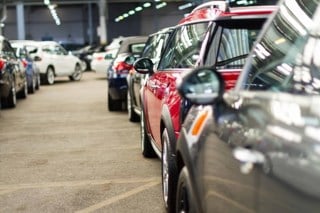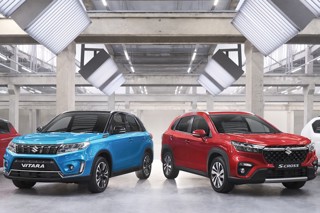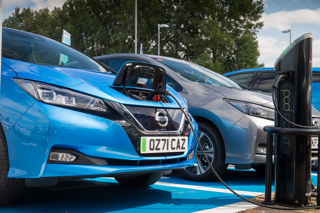What were your immediate priorities after being appointed CEO in July?
I have a ‘do less, execute well’ mentality. Cox was trying to do too much. We needed to redefine and focus on what I call ‘core plus’. Core is our B2B wholesale business; the plus is our adjacencies, the businesses that drive the core – Nextgear, our funding arm for dealers to buy stock, and Movex, our de-fleet and refurbish services.
We created confusion in the past. Now we have a simple structure – Dealer Auctions, our new joint venture with Auto Trader; Manheim, our auction centres, inspect and collect, and de-fleet; NextGear; and Modix, our digital marketing solution.
We had to simplify what Cox Automotive means – to our people internally and externally to the trade.
What do you want Cox to mean and how do you plan to further evolve?
We should be seen as an automotive leader, the go-to company in the B2B marketplace. We need to provide solutions to problems, whether that’s for dealers, buyers, sellers, manufacturers, fleets or leasing companies. We pull together services to create efficiencies to maximise our customers’ profits and make them more viable commercially.
We are seeing immense change in our industry. If we continue with the strategy we have, we will become irrelevant.
Manheim and remarketing is our bread and butter, even though we have a portfolio of services. But it is under attack and evolving from many angles. Vendors are placing cars further upstream and avoiding the auction. Others are moving to digital platforms – either their own or via a third party – and we see less going through physical auction.
We also have buyers looking at different ways to buy stock. There is not enough of the right stock in the market and they are becoming savvy and going to the source, missing out the middleman. Physical auction is not
dead, but we have to evolve, and this is through digital.
We need to be a remarketing service that is omni-channel and channel-agnostic. Vendors shouldn’t care about which channels we use, just about getting more value and how quickly we sell the stock. This was our core focus as we moved into 2018. Now we have to execute the plan.
How does the Auto Trader joint venture feed into this strategy?
Auto Trader has years of digital experience and platforms and it has the data. But it doesn’t have the understanding of the wholesale market or the ability to move metal. We’ve seen players come in with excellent technical platforms, but then they realise that the metal has to be collected, moved from A to B, refurbished and stored. They have all come and gone.
We have seen leasing companies using their own platforms and manufacturer captives using third parties so we have had to be brave because we are now disrupting our industry and our own business by shifting from physical to digital.
Dealer Auction will allow us to aggregate stock in the marketplace. Right now, it’s a fragmented market for buyers. They log on to the auction websites to see stock with different contracts, different grading and different photos, and a lack of data – it’s too much art and not enough science.
We are trying to create an environment where stock is put into an aggregated pool so buyers can see everything that is available. If they want to transact online they can, but, if they don’t, they can still go to the auction centre, whether that’s one of ours or a rival business.
There is no reason why any leasing company with a solus remarketing agreement from a physical environment wouldn’t want to put their vehicles up on a digital environment first where you have 13,000 dealers, especially if that reduces the days in stock and increases values. We can provide that service.
What other benefits does Dealer Auction offer buyers and sellers?
The average buyer fee on Dealer Auction today is £60; at physical auction it is £200-£250. From a vendor perspective, the car can go up within hours. For physical auction, it can take up to 14 days. We are seeing sales prices go up on Dealer Auction by a couple of percentage points because dealers are taking the buyer fee into consideration, so they are able to bid more for the car.
What does your future strategy mean for your 16 UK auction centres?
We have to be open and honest – will we have 16 in two or three years’ time? The answer is no. Physical auction isn’t dead and buried – just come to Colchester on a Friday night to see that – but there is stock that is relevant for digital, such as manufacturer and fleet/leasing stock with a younger age profile, and an element that suits the physical lane, such as dealer part-ex. We will reconfigure our locations. We will have fewer sites, but they will be placed around the country. We will have to complement digital sales by going into de-fleet and refurbishment in a much bigger way. The journey starts now, but it will be 2023/24 by the time we have reconfigured with the right capabilities in the right locations. We will need to stay fluid and agile because we don’t know the speed of movement to online.
What proportion of sales are digital today and how do you see the shift evolving?
Including Simulcast, we sell 25-30% of stock in an online environment. If I look at Dealer Auction, every month is a record month. In 2019, we will be close to selling 100,000 vehicles online. It was the lower end of the stock profile, but we are seeing cars getting younger and prices rising. We predicted that 80% of wholesale stock would be sold online by 2023, but I’m not hung up on the details. Whether it’s 60% or 80%, 2023 or
2025, our statement shows the direction of travel.
What does a great end-to-end remarketing service look like?
We collect the car from the manufacturer, fleet or leasing company; it goes online; we store it at our de-fleet centre; we recondition it ready for wholesale; the car is bought by a dealer; we offer the dealer a service to make the car retail-ready; the dealer puts the car on their website – they could have even sold it already – and we move the vehicle to their forecourt or do the handover at the customer’s address.
Our world is not about going to the consumer – it’s either a full end-to-end proposition that allows the dealer, fleet and leasing company to keep pace with the market, or it’s offering component parts, such as a part-exchange service, digital marketing strategies, live chat and finance to the point that the consumer buys the car.
Will you have to put greater resources into de-fleet to accommodate this level of service?
Yes, that will be a big focus in 2019. We will have to invest heavily to increase our capabilities. Reconditioning to retail-ready is where we don’t have sufficient capacity. We want to be able to offer those services at scale by the end of 2019.
Could those centres offer alternative services as well?
When we look at Mobility as a Service (MaaS), having supercentres where you can manage, service and maintain those cars will be key. Where will an autonomous vehicle go for maintenance? We are an expert in dealing with metal, so we see that as an area of potential as we grow our capability. Having de-fleet centres with duality of purpose will increase our footprint as MaaS, transport as a service and subscription models start to take hold.
How will mobility services change the dealer and remarketing environments?
We see a massive shift into mobility. I see the industry going the same way as the mobile phone, where people buy credits and different packages. It’s not ownership, but a rental model where people can shift in and out of cars depending on their need. I also see a world where there is no subscription – it’s simply a click of a button and a car turns up to collect you. We already have this in big cities, with the likes of Uber.
What does this mean for dealers? Do subscription models mean an end to the used car market?
There is still some way to go before that happens. Our US modelling shows a drop in the used market around 2025, but it won’t disappear. We see a used market for the foreseeable future, although there will be a slight rise in mobility services in 2023/24 versus ownership of cars.
Dealer consolidation will continue, more so because margins are thin and you can improve them with the economies of scale and efficiencies offered by consolidation. We don’t see the death of the dealer model – there is still a lot for them to play for. But the tension between dealers and manufacturers needs to be worked out. The requirement for gin palaces and huge investments when manufacturers are trying to move sales online brings into question the role of the dealer.
Are they a shop window with the customer buying online and going back to the dealership for the handover and repair? Do they become a facilitator, making their money from servicing? But if we move to electric vehicles, how much servicing will they see?
There are a lot of unanswered questions, but it’s not something that will change for 12, 18, 24 months. The dealer is still important to the consumer.
What about the threat posed by the likes of Amazon, Google and Facebook?
They have enormous wealth and talent. Will it change where cars are advertised? Do they go to sites known for selling cars or do the cars go to the sites where the eyeballs are, such as Snapchat? We have to watch them with a laser eye to understand how they might disrupt because of their resources and understanding of logistics. Google, with its focus on technology and autonomous vehicles, plays into our strategy because it won’t want to move into a world of complexity when it comes to storing and moving metal. But Amazon could be a threat to dealers – they are the ultimate disrupter. Disruption is coming from all angles and it comes down to the ones that can evolve and adapt the quickest.
A straight question: do you want to be the biggest remarketing company in the UK?
The B2B market is worth £500 million today. We have the number two share of that, with 400,000-450,000 vehicle transactions. We do have an ambition to be number one and we’ve not ruled out acquisitions as well as organic growth, both physical and digital and also adjoining businesses. But what’s important is that we also have to be a disrupter – if we don’t do it, others will. Stephen Briers



















Login to comment
Comments
No comments have been made yet.